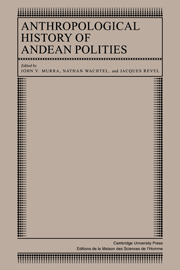Book contents
- Frontmatter
- Contents
- List of contributors
- Preface
- Introduction
- Part I Ecology and society
- Part II The ethnic group and the state
- Part III Systems of classification
- Part IV Symbolic representations and practices
- 11 Inka dynasty and irrigation: another look at Andean concepts of history
- 12 Urco and uma: Aymara concepts of space
- 13 Mirrors and maize: the concept of yanantin among the Macha of Bolivia
- 14 From asymmetry to triangle: symbolic transformations in northern Potosí
- Part V From ethnic polities to communities
- Bibliography of published source
- Index
11 - Inka dynasty and irrigation: another look at Andean concepts of history
Published online by Cambridge University Press: 05 October 2010
- Frontmatter
- Contents
- List of contributors
- Preface
- Introduction
- Part I Ecology and society
- Part II The ethnic group and the state
- Part III Systems of classification
- Part IV Symbolic representations and practices
- 11 Inka dynasty and irrigation: another look at Andean concepts of history
- 12 Urco and uma: Aymara concepts of space
- 13 Mirrors and maize: the concept of yanantin among the Macha of Bolivia
- 14 From asymmetry to triangle: symbolic transformations in northern Potosí
- Part V From ethnic polities to communities
- Bibliography of published source
- Index
Summary
Introduction
In my study entitled “The Ceque System of Cuzco: The Social Organization of the Capital of the Inca” (Zuidema 1964; Wachtel 1966) I described the Inka concepts of social and political organization in the framework of their history. Although it had always been recognized that this historical tradition included mythical and legendary elements, nonetheless Spanish chroniclers and later students accepted the general framework as a reasonable working hypothesis. Manco Capac, the mythical founder of the Inka dynasty, was succeeded by four kings belonging to Hurin, or Lower, Cusco – Sinchi Roca, Lloque Yupanqui, Mayta Capac, and Capac Yupanqui – followed by five kings of Hanan, or Upper Cusco – Inca Roca, Yahuar Huacac, Viracocha Inca, Pachacuti Inca, and Tupac Yupanqui. The last king before the Spanish conquest, Huayna Capac, did not die in Cusco and was not included in this dichotomy. It was during the civil war between his sons Huascar and Atahuallpa that the Spaniards, after the defeat of the latter in Cajamarca in 1532, conquered the country.
Here is an indication of a social dichotomy within a genealogical and historical framework, but what does this dichotomy mean in terms of sociopolitical organization, kinship, and territorial divisions?
I then came across the versions of Inka history by Polo de Ondegardo ([1571] 1916) and Gutierrez de Santa Clara ([1556] 1963–5). The first chronicler has always been considered as one of our most important and trustworthy sources.
- Type
- Chapter
- Information
- Anthropological History of Andean Polities , pp. 177 - 200Publisher: Cambridge University PressPrint publication year: 1986
- 19
- Cited by



